A chance to think through how the visual impact of text, image, and text with image.
24 Items in this Learning Collection
Collection Object
Collection Object
Collection Object
Collection Object
Collection Object
Collection Object
Collection Object
Collection Object
Collection Object
Collection Object
Collection Object
Collection Object
Collection Object
Collection Object
Collection Object
Collection Object
Collection Object
Collection Object
Collection Object
Collection Object
Collection Object
Copyright
All Rights Reserved
()
Sunrise at Benten Shrine, Suzaki Cape
Accession Number
1954/1.471
Title
Sunrise at Benten Shrine, Suzaki Cape
Artist(s)
Katsushika Hokusai
Object Creation Date
1800-1820
Medium & Support
koban surimono (privately published) color woodblock print (nishiki e) on paper
Dimensions
5 3/16 in x 7 3/16 in (13.18 cm x 18.26 cm);5 1/4 in x 7 1/4 in (13.34 cm x 18.41 cm);8 9/16 in x 11 1/8 in (21.75 cm x 28.26 cm);14 5/16 in x 19 3/8 in (36.35 cm x 49.21 cm)
Credit Line
Bequest of Margaret Watson Parker
Label copy
In the final decade of the eighteenth century, there was a severe wave of government censorship against any publications—image or text—that could be construed as political satire or as detrimental to public morals. At first this crackdown had a devastating impact on print publishers and artists, who found themselves in manacles if they attempted to continue their staple products of erotica and pin-up prints of courtesans and actors. They soon rebounded, however, with new formats and new themes. One outlet for artistic genius was the surimono, the privately commissioned print that could avoid the censor’s eye. Usually issued as New Year’s greetings by members of a poetry club or clique, surimono are small in scale and richly decorated with the highest quality pigments, including metallic shades of silver, gold, and copper.
Katsushika Hokusai, who is best known in the West for his landscape prints of Mount Fuji, evokes here a quietly nostalgic scene. Two geisha (itinerant musicians) are shown strolling in the countryside, with the roof of a Shintô shrine in the distance. The backdrop is the rising sun—the give-away that this is a New Year’s print—seen over distant mountains and a calm bay. The women seem unimpressed by nature’s display: one stoops to empty the ashes from her pipe, while the other draws her kimono closely about her, against the chill of the dawn.
M. Graybill
"Courtesans, Cross-Dressers, and the Girl Next Door Images of the Feminine in Japanese Popular Prints"
3/9 - 9/1/02
Subject matter
In the final decade of the eighteenth century, there was a severe wave of government censorship against any publications—image or text—that could be construed as political satire or as detrimental to public morals. At first this crackdown had a devastating impact on print publishers and artists, who found themselves in manacles if they attempted to continue their staple products of erotica and pin-up prints of courtesans and actors. They soon rebounded, however, with new formats and new themes. One outlet for artistic genius was the surimono, the privately commissioned print that could avoid the censor’s eye. Usually issued as New Year’s greetings by members of a poetry club or clique, surimono are small in scale and richly decorated with the highest quality pigments, including metallic shades of silver, gold, and copper.
Katsushika Hokusai, who is best known in the West for his landscape prints of Mount Fuji, evokes here a quietly nostalgic scene of two geisha (itinerant musicians) strolling in the countryside, with the roof of a Shintô shrine in the distance. The backdrop is the rising sun—the give-away that this is a New Year’s print—seen over distant mountains and a calm bay. The women seem unimpressed by nature’s display: one stoops to empty the ashes from her pipe, while the other draws her kimono closely about her, against the chill of the dawn. A poem, possibly by Akashi tei urabito, lies above the rising sun in the top left register.
Physical Description
Two geisha (itinerant musicians) are shown strolling in the countryside, with the roof of Benten Shintô shrine in the distance. The backdrop is the rising sun—the give-away that this is a New Year’s print—seen over distant mountains and a calm bay. One woman stoops to empty the ashes from her pipe, while the other draws her kimono closely about her. A poem lies just above the rising sun in the top left register of the morning sky.
Primary Object Classification
Print
Primary Object Type
color print
Collection Area
Asian
Rights
If you are interested in using an image for a publication, please visit http://umma.umich.edu/request-image for more information and to fill out the online Image Rights and Reproductions Request Form.
Keywords
calligraphy (process)
kimonos
poems
riverbanks
rivers
sunrise
women (female humans)
1954/1.471
Title
Sunrise at Benten Shrine, Suzaki Cape
Artist(s)
Katsushika Hokusai
Object Creation Date
1800-1820
Medium & Support
koban surimono (privately published) color woodblock print (nishiki e) on paper
Dimensions
5 3/16 in x 7 3/16 in (13.18 cm x 18.26 cm);5 1/4 in x 7 1/4 in (13.34 cm x 18.41 cm);8 9/16 in x 11 1/8 in (21.75 cm x 28.26 cm);14 5/16 in x 19 3/8 in (36.35 cm x 49.21 cm)
Credit Line
Bequest of Margaret Watson Parker
Label copy
In the final decade of the eighteenth century, there was a severe wave of government censorship against any publications—image or text—that could be construed as political satire or as detrimental to public morals. At first this crackdown had a devastating impact on print publishers and artists, who found themselves in manacles if they attempted to continue their staple products of erotica and pin-up prints of courtesans and actors. They soon rebounded, however, with new formats and new themes. One outlet for artistic genius was the surimono, the privately commissioned print that could avoid the censor’s eye. Usually issued as New Year’s greetings by members of a poetry club or clique, surimono are small in scale and richly decorated with the highest quality pigments, including metallic shades of silver, gold, and copper.
Katsushika Hokusai, who is best known in the West for his landscape prints of Mount Fuji, evokes here a quietly nostalgic scene. Two geisha (itinerant musicians) are shown strolling in the countryside, with the roof of a Shintô shrine in the distance. The backdrop is the rising sun—the give-away that this is a New Year’s print—seen over distant mountains and a calm bay. The women seem unimpressed by nature’s display: one stoops to empty the ashes from her pipe, while the other draws her kimono closely about her, against the chill of the dawn.
M. Graybill
"Courtesans, Cross-Dressers, and the Girl Next Door Images of the Feminine in Japanese Popular Prints"
3/9 - 9/1/02
Subject matter
In the final decade of the eighteenth century, there was a severe wave of government censorship against any publications—image or text—that could be construed as political satire or as detrimental to public morals. At first this crackdown had a devastating impact on print publishers and artists, who found themselves in manacles if they attempted to continue their staple products of erotica and pin-up prints of courtesans and actors. They soon rebounded, however, with new formats and new themes. One outlet for artistic genius was the surimono, the privately commissioned print that could avoid the censor’s eye. Usually issued as New Year’s greetings by members of a poetry club or clique, surimono are small in scale and richly decorated with the highest quality pigments, including metallic shades of silver, gold, and copper.
Katsushika Hokusai, who is best known in the West for his landscape prints of Mount Fuji, evokes here a quietly nostalgic scene of two geisha (itinerant musicians) strolling in the countryside, with the roof of a Shintô shrine in the distance. The backdrop is the rising sun—the give-away that this is a New Year’s print—seen over distant mountains and a calm bay. The women seem unimpressed by nature’s display: one stoops to empty the ashes from her pipe, while the other draws her kimono closely about her, against the chill of the dawn. A poem, possibly by Akashi tei urabito, lies above the rising sun in the top left register.
Physical Description
Two geisha (itinerant musicians) are shown strolling in the countryside, with the roof of Benten Shintô shrine in the distance. The backdrop is the rising sun—the give-away that this is a New Year’s print—seen over distant mountains and a calm bay. One woman stoops to empty the ashes from her pipe, while the other draws her kimono closely about her. A poem lies just above the rising sun in the top left register of the morning sky.
Primary Object Classification
Primary Object Type
color print
Collection Area
Asian
Rights
If you are interested in using an image for a publication, please visit http://umma.umich.edu/request-image for more information and to fill out the online Image Rights and Reproductions Request Form.
Keywords
calligraphy (process)
kimonos
poems
riverbanks
rivers
sunrise
women (female humans)
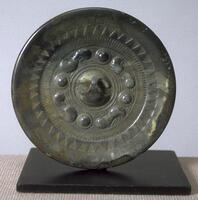
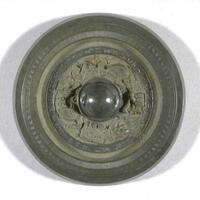






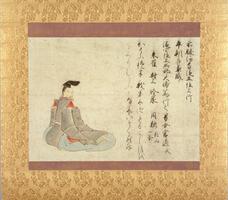
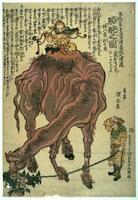

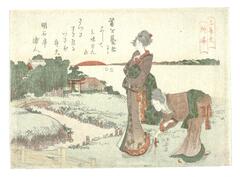
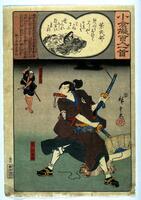



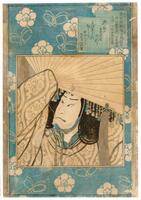
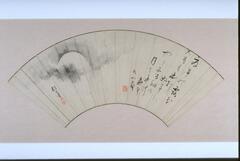

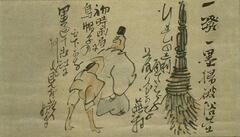

![In this monumental scroll, Nukina Kaioku has brushed a Chinese poem of his own composition, on the enduring theme of nature as refreshment for the spirit. Note his masterful variation of thick and thin strokes, wet and dry ink, stately and rapid movement.<br />The verses may be tentatively rendered into English as follows:<br /> Mandarin ducks enjoy the fresh water; their graceful forms glow as they pass through channels in the reeds.<br /> Pushing beyond the thickets [to the open pond], they call to one another again and again in the dawn.<br /> A crimson mist breaks through gaps in the glade, its glow warming hidden nests.<br /> Waking up with nothing to do, [I came here] to playfully row among the spring waves. In this monumental scroll, Nukina Kaioku has brushed a Chinese poem of his own composition, on the enduring theme of nature as refreshment for the spirit. Note his masterful variation of thick and thin strokes, wet and dry ink, stately and rapid movement.<br />The verses may be tentatively rendered into English as follows:<br /> Mandarin ducks enjoy the fresh water; their graceful forms glow as they pass through channels in the reeds.<br /> Pushing beyond the thickets [to the open pond], they call to one another again and again in the dawn.<br /> A crimson mist breaks through gaps in the glade, its glow warming hidden nests.<br /> Waking up with nothing to do, [I came here] to playfully row among the spring waves.](/media/W1siZiIsIjIwMjIvMDUvMjUvNDA4bXZmMmt5bF9kZWZhdWx0LmpwZyJdLFsicCIsInRodW1iIiwiMjQweDIwMCJdXQ?sha=1fda6bad9ec42b3f)


